The NVIDIA GeForce GTX 780 Ti Review
by Ryan Smith on November 7, 2013 9:01 AM ESTCompute
Jumping into compute, we’re entering the one area where GTX 780 Ti’s rule won’t be nearly as absolute. Among NVIDIA cards its single precision performance will be unchallenged, but the artificial double precision performance limitation as compared to the compute-focused GTX Titan means that GTX 780 Ti will still lose to GTX Titan whenever double precision comes into play. Alternatively, GTX 780 Ti still has to deal with the fact that AMD’s cards have shown themselves to be far more competitive in our selection of compute benchmarks.
As always we'll start with our DirectCompute game example, Civilization V, which uses DirectCompute to decompress textures on the fly. Civ V includes a sub-benchmark that exclusively tests the speed of their texture decompression algorithm by repeatedly decompressing the textures required for one of the game’s leader scenes. While DirectCompute is used in many games, this is one of the only games with a benchmark that can isolate the use of DirectCompute and its resulting performance.
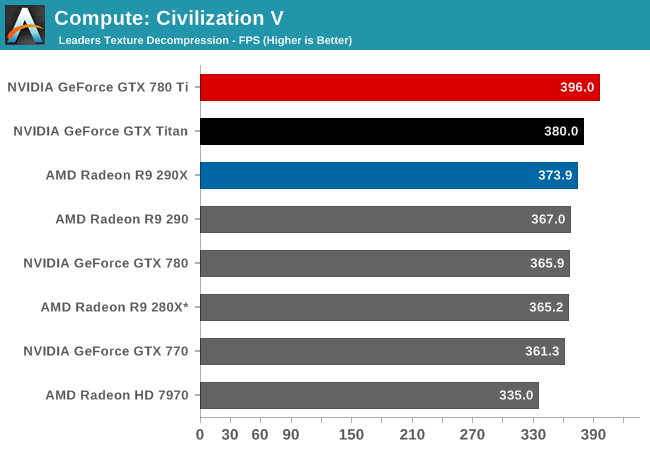
Even though we’re largely CPU bound by this point, GTX 780 Ti manages to get a bit more out of Civilization V’s texture decode routine, pushing it to the top of the charts and ahead of both GTX Titan and 290X.
Our next benchmark is LuxMark2.0, the official benchmark of SmallLuxGPU 2.0. SmallLuxGPU is an OpenCL accelerated ray tracer that is part of the larger LuxRender suite. Ray tracing has become a stronghold for GPUs in recent years as ray tracing maps well to GPU pipelines, allowing artists to render scenes much more quickly than with CPUs alone.
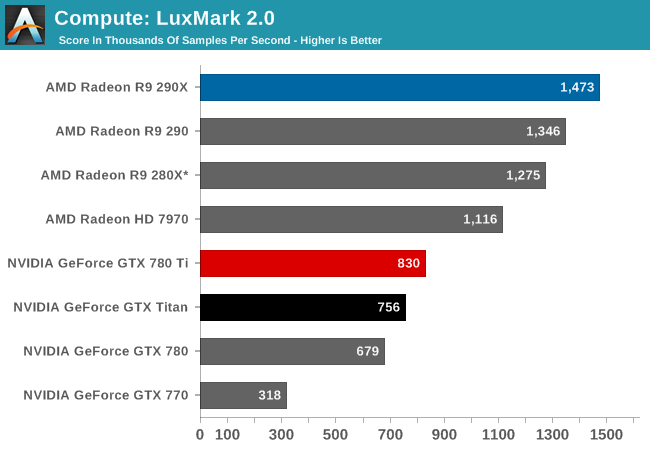
With LuxMark NVIDIA’s ray tracing performance sees further improvements due to the additional compute resources at hand. But NVIDIA still doesn’t fare well here, with the GTX 780 Ti falling behind all of our AMD cards in this test.
Our 3rd compute benchmark is Sony Vegas Pro 12, an OpenGL and OpenCL video editing and authoring package. Vegas can use GPUs in a few different ways, the primary uses being to accelerate the video effects and compositing process itself, and in the video encoding step. With video encoding being increasingly offloaded to dedicated DSPs these days we’re focusing on the editing and compositing process, rendering to a low CPU overhead format (XDCAM EX). This specific test comes from Sony, and measures how long it takes to render a video.

Like LuxMark, GTX 780 Ti once again improves on its predecessors. But it’s not enough to make up for AMD’s innate performance advantage in this benchmark, leading to GTX 780 Ti trailing all of the AMD cards.
Our 4th benchmark set comes from CLBenchmark 1.1. CLBenchmark contains a number of subtests; we’re focusing on the most practical of them, the computer vision test and the fluid simulation test. The former being a useful proxy for computer imaging tasks where systems are required to parse images and identify features (e.g. humans), while fluid simulations are common in professional graphics work and games alike.
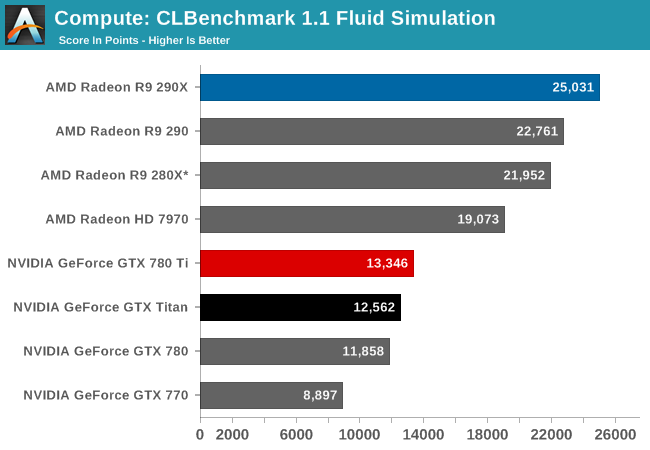
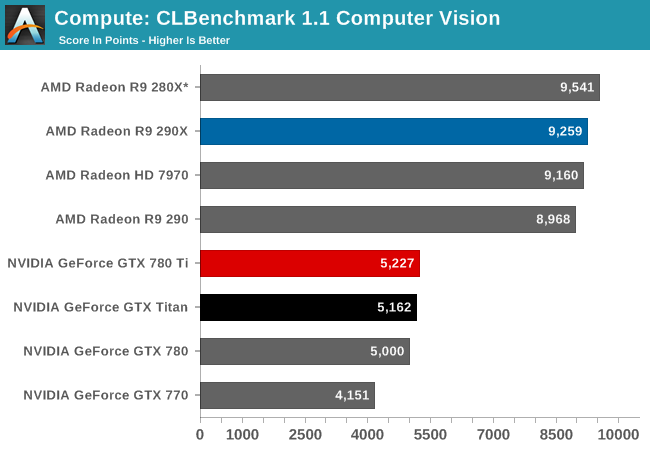
CLBenchmark continues to be the same story. GTX 780 Ti improves on NVIDIA’s performance to become their fastest single precision card, but it still falls short of every AMD card in these tests.
Moving on, our 5th compute benchmark is FAHBench, the official Folding @ Home benchmark. Folding @ Home is the popular Stanford-backed research and distributed computing initiative that has work distributed to millions of volunteer computers over the internet, each of which is responsible for a tiny slice of a protein folding simulation. FAHBench can test both single precision and double precision floating point performance, with single precision being the most useful metric for most consumer cards due to their low double precision performance. Each precision has two modes, explicit and implicit, the difference being whether water atoms are included in the simulation, which adds quite a bit of work and overhead. This is another OpenCL test, as Folding @ Home has moved exclusively to OpenCL this year with FAHCore 17.

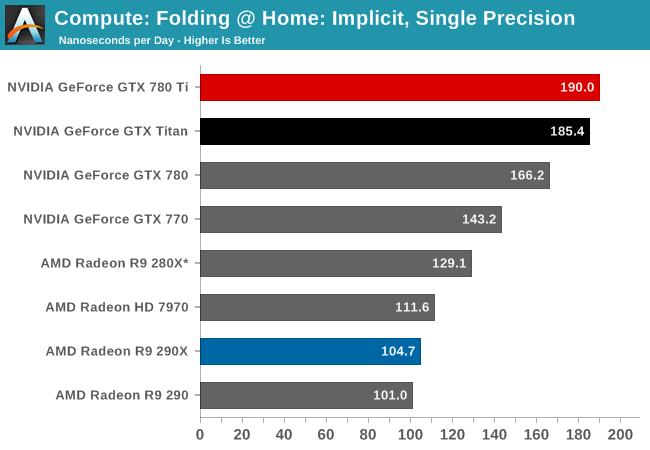
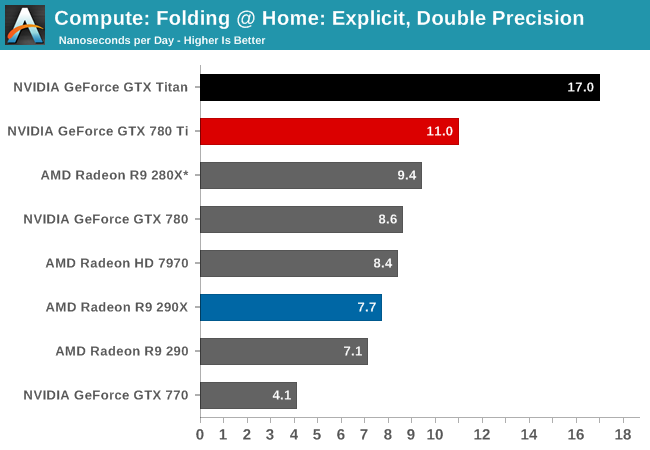
Finally with Folding@Home we see the GTX 780 Ti once again take the top spot. In the single precision tests the GTX 780 further extends NVIDIA’s lead, beating GTX Titan by anywhere between a few percent to over ten percent depending on which specific test we’re looking at. However even with GTX 780 Ti’s general performance increase, in the double precision test it won’t overcome the innate double precision performance deficit it faces versus GTX Titan. When it comes to double precision compute, Titan remains king.
Wrapping things up, our final compute benchmark is an in-house project developed by our very own Dr. Ian Cutress. SystemCompute is our first C++ AMP benchmark, utilizing Microsoft’s simple C++ extensions to allow the easy use of GPU computing in C++ programs. SystemCompute in turn is a collection of benchmarks for several different fundamental compute algorithms, as described in this previous article, with the final score represented in points. DirectCompute is the compute backend for C++ AMP on Windows, so this forms our other DirectCompute test.
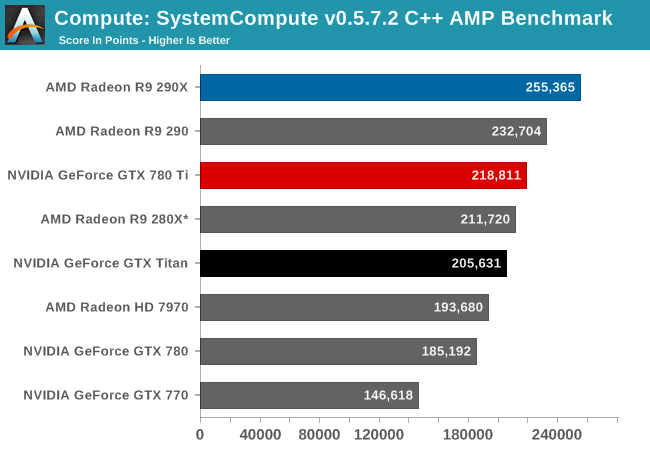
Last, in our C++ AMP benchmark we see the GTX 780 Ti take the top spot for an NVIDIA card, but like so many of our earlier compute tests it will come up short versus AMD’s best cards. This isn’t quite as lopsided as some of our other tests, however GTX 780 Ti is stuck competing with the 280X while the 290 and 290X easily outperform NVIDIA’s new flagship.










302 Comments
View All Comments
bigboxes - Thursday, November 7, 2013 - link
"Doesn't bode well." Just zip it.TheJian - Thursday, November 7, 2013 - link
https://www.youtube.com/watch?v=m1JOhT015wwFast forward to 8:35 or so...Got smashed, both OC'ed to the max. In Uber as anandtech even showed, it hits it's max all day. So 1ghz won't get more, and they run higher than that at linustechtips (both cards oced max they could get). Nowhere close in any benchmark they run. Don't forget you can clock the crap out of 780TI as already shown everywhere. If you're assuming a "Properly Cooled" ghz edition beats 780ti well we've only seen REF 780TI's so far too right? So what does a "Properly Cooled" 780ti do? They hit 1200-1300 stock fan. Will they hit 1300-1400 with an aftermarket fan? You won't catch it as it is without water and you'll need to be way over 1ghz to do it and pulling more watts no doubt.
What record are you giving? Assumptions and guesswork that goes against all current info from MANY sites. Check out all the sites I listed. That is what we call "for the record".
http://www.techpowerup.com/reviews/NVIDIA/GeForce_...
Only 1120/1175 (base/boost) and it's 30.8% faster than UBER 290x. Not even sure water would catch this and this is a WEAK OC compared to other sites like overclockers hitting 1291/1304. They can do this out of the box.
whiteswolf - Sunday, June 8, 2014 - link
to let you know the nvidea gtx 780 ti is walking and not breaking sweat. while the amdsare running think of it this way. if you over clock or make nvidea gtx 780 ti sprint it is said int can get a 19% to 20% boost in performence. and it only gets noise and sound of amds card.Da W - Thursday, November 7, 2013 - link
The only thing louder than a 290X is a Nvidia Fanboy.HisDivineOrder - Thursday, November 7, 2013 - link
Actually, I think the louder thing still is the sound of AMD fanboys coming into a review of a new nVidia halo product and crying about "nvidia fanboys." ;)OverclockedCeleron - Thursday, November 7, 2013 - link
Well, ask your colleague troll not to bring AMD trash talk into an Nvidia article. (See first comment to this article).bigboxes - Thursday, November 7, 2013 - link
Haha!Flunk - Thursday, November 7, 2013 - link
Sure, if you like to throw money away. Nvidia could seriously destroy AMD on this generation, but they're choosing not to compete by not pricing in line with performance.I personally think AMD has the edge when it comes to cost/unit because their chip is smaller, which is how they can price so much lower.
1Angelreloaded - Thursday, November 7, 2013 - link
See its about the feature sets as well that determine price, and of course support. The 289x should have been released with the 600 series not the end of the 700 series and at the edge of starting the 800 series in a few months with Maxwell.1Angelreloaded - Thursday, November 7, 2013 - link
edit "290x"